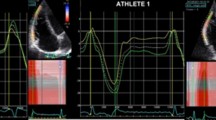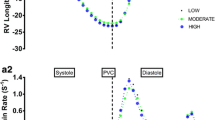Abstract
To describe cardiac remodeling in a population of male master athletes evaluated by transthoracic echocardiography and to analyse its relationship with several exercise-related characteristics. A total of 105 male master athletes aged ≥ 40 years old, mostly involved in endurance sports (81.0%) with a median training-volume of 66 [44; 103] METs/h/week, were studied. Left ventricular end-diastolic and end-systolic volumes were above the references in 84.8% and 75.8% athletes, decreasing in frequency when adjusted for BSA (26.3% and 23.2%). LV geometry was changed in more than half of the athletes (eccentric hypertrophy 28.3%, concentric remodelling 15.2% and concentric hypertrophy 8.1%) and several right ventricular (RV) dimensions were increased. Left atrium was dilated in 53.5% and right atrium in 37.4% athletes; only one athlete had a dilated aorta. Mean LV ejection fraction was 61 ± 7% and global longitudinal strain − 18.3 ± 2.0%. Changes in LV geometry were more common in high intensity sports; LV dilation in athletes exercising > 10 h/week and in high intensity sports; RV dilation in athletes exercising > 66 MET-hour/week and in endurance sports. In multivariate analysis high intensity sports remained an independent predictor of changes in LV geometry. A significant proportion of male master athletes showed altered echocardiographic parameters compared to the reference values, more pronounced in those involved in endurance sports, with high intensity and high volume of exercise. This may correspond to exercise-induced physiological adaptations, reinforcing the concept that the characteristics of exercise are major determinants of cardiac remodeling and should be considered during athletes’ evaluation.



Similar content being viewed by others
References
Dores H, Freitas A, Malhotra A et al (2015) ‘The heart of competitive athletes’—an updated overview of exercise-induced cardiac adaptations. Rev Port Cardiol 34:51–64
Wilson M, O’Hanlon R, Basavarajaiah S et al (2010) Cardiovascular function and the veteran athlete. Eur J Appl Physiol 110:459–478
Hood S, Northcote RJ (1999) Cardiac assessment of veteran endurance athletes: a 12 year follow up study. Br J Sports Med 33:239–243
Merghani A, Malhotra A, Sharma S (2015) The U-shaped relationship between exercise and cardiac morbidity. Trends Cardiovasc Med 26(3):232–240
Braber TL, Mosterd A, Prakken NH et al (2016) Occult coronary artery disease in middle-aged sportsmen with a low cardiovascular risk score: the Measuring Athlete’s Risk of Cardiovascular Events (MARC) study. Eur J Prev Cardiol 23:1677–1684
Dores H, de Araújo Gonçalves P, Monge J et al (2018) Subclinical coronary artery disease in veteran athletes: is a new preparticipation methodology required? Br J Sports Med. https://doi.org/10.1136/bjsports-2018-099840
Scharf M, Brem MH, Wilhelm M et al (2010) Cardiac magnetic resonance assessment of left and right ventricular morphologic and functional adaptations in professional soccer players. Am Heart J 159:911–918
Zaidi A, Ghani S, Sharma R et al (2013) Physiological right ventricular adaptation in elite athletes of African and Afro-Caribbean origin. Circulation 127:1783–1792
Sanchis-Gomar F, López-Ramón M, Alis R et al (2016) No evidence of adverse cardiac remodeling in former elite endurance athletes. Int J Cardiol 222:171–177
Pavlik G, Olexó Z, Osváth P et al (2001) Echocardiographic characteristics of male athletes of different age. Br J Sports Med 35:95–99
Rizzo M, Spataro A, Cecchetelli C et al (2012) Structural cardiac disease diagnosed by echocardiography in asymptomatic young male soccer players: implications for pre-participation screening. Br J Sports Med 46:371–373
Conroy RM, Pyorala K, Fitzgerald AP et al (2003) Estimation of ten-year risk of fatal cardiovascular disease in Europe: the SCORE project. Eur Heart J 24:987–1003
Sharma S, Drezner JA, Baggish A et al (2017) International recommendations for electrocardiographic interpretation in athletes. J Am Coll Cardiol 69:1057–1075
Pelliccia A, Sharma S, Gati S et al (2021) 2020 ESC Guidelines on sports cardiology and exercise in patients with cardiovascular disease. Eur Heart J 42:17–96
Ainsworth BE, Haskell WL, Herrmann SD et al (2011) Compendium of physical activities: a second update of codes and MET values. Med Sci Sports Exerc 43:1575–1581
Lang RM, Badano LP, Victor Mor-Avi V et al (2015) Recommendations for cardiac chamber quantification by echocardiography in adults: an update from the American Society of Echocardiography and the European Association of Cardiovascular Imaging. Eur Heart J Cardiovasc Imaging 16:233–270
Cantinotti M, Koestenberger M, Santoro G et al (2020) Normal basic 2D echocardiographic values to screen and follow up the athlete’s heart from juniors to adults: what is known and what is missing. A critical review. Eur J Prev Cardiol 27:1294–1306
Morganroth J, Maron BJ, Henry WL et al (1975) Comparative left ventricular dimensions in trained athletes. Ann Intern Med 82:521–524
Utomi V, Oxborough D, Ashley E et al (2014) Predominance of normal left ventricular geometry in the male “athlete’s heart.” Heart 100:1264–1271
Ryffel CP, Eser P, Tracshsel L et al (2018) Age at start of endurance training is associated with patterns of left ventricular hypertrophy in middle-aged runners. Int J Cardiol 267:133–138
Finocchiaro G, Dhutia H, D’Silva A et al (2017) Effect of sex and sporting discipline on LV adaptation to exercise. J Am Coll Cardiol Imaging 10:965–972
Ascenzi F, Pelliccia A, Corrado D et al (2016) Right ventricular remodelling induced by exercise training in competitive athletes. Eur Heart J Cardiovasc Imaging 17:301–307
Pelliccia A, Maron BJ, Di Paolo F et al (2005) Prevalence and clinical significance of left atrial remodeling in competitive athletes. J Am Coll Cardiol 46:690–696
Cuspidi C, Sala C, Tadic M et al (2019) Left atrial volume in elite athletes: a meta-analysis of echocardiographic studies. Scand J Med Sci Sports 29:922–932
Iskandar A, Mujtaba MT, Thompson PD (2015) Left atrium size in elite athletes. J Am Coll Cardiol Imaging 8:753–762
Iskandar A, Thompson PD (2013) A meta-analysis of aortic root size in elite athletes. Circulation 127:791–798
Hedley JS, Phelan D (2017) Athletes and the aorta: normal adaptations and the diagnosis and management of pathology. Curr Treat Options Cardiovasc Med 19:88
Pelliccia A, Culasso F, Di Paolo F, Maron BJ (1999) Physiologic left ventricular cavity dilatation in elite athletes. Ann Intern Med 130:23–31
Abergel E, Chatellier G, Hagege A et al (2004) Serial left ventricular adaptations in world-class professional cyclists implications for disease screening and follow-up. Am Coll Cardiol 44:144–149
Dores H, Mendes L, Dinis P et al (2018) Myocardial deformation and volume of exercise: a new overlap between pathology and athlete’s heart? Int J Cardiovasc Imaging 34:1869–1875
Dores H, Gonçalves PA, Monge J et al (2020) Coronary atherosclerotic burden in veteran male recreational athletes with low to intermediate cardiovascular risk. Rev Port Cardiol 39:587–594
Pelliccia A, Kinoshita N, Pisicchio C et al (2010) Long-term clinical consequences of intense, uninterrupted endurance training in Olympic athletes. J Am Coll Cardiol 55:1619–1625
Pelliccia A, Maron BJ, De Luca R et al (2002) Remodeling of left ventricular hypertrophy in elite athletes after long-term deconditioning. Circulation 105:944–949
George K, Whyte G, Green D et al (2012) The endurance athletes heart: acute stress and chronic adaptation. Br J Sports Med 46:i29–i36
Niedersser D, Rossi VA, Kissel C et al (2020) Role of echocardiography in screening and evaluation of athletes. Heart 0:1–7. https://doi.org/10.1136/heartjnl-2020-317996
Acknowledgements
We thank all the participants, the cardiologists and technicians involved in this study.
Funding
No funding or financial support was specifically provided for this study.
Author information
Authors and Affiliations
Corresponding author
Ethics declarations
Conflict of interest
All authors declare that they have no conflict of interest.
Additional information
Publisher's Note
Springer Nature remains neutral with regard to jurisdictional claims in published maps and institutional affiliations.
Rights and permissions
About this article
Cite this article
Dores, H., de Araújo Gonçalves, P., Monge, J. et al. Cardiac remodeling induced by exercise in Caucasian male master athletes: a cross-sectional study. Int J Cardiovasc Imaging 38, 69–78 (2022). https://doi.org/10.1007/s10554-021-02368-z
Received:
Accepted:
Published:
Issue Date:
DOI: https://doi.org/10.1007/s10554-021-02368-z




